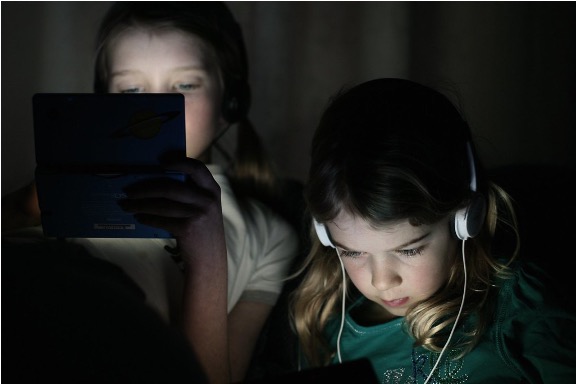It’s hard to think back to a time where our lives were not virtual; where school was in person, and meetings were held in an office, not in our living room. Although there have been benefits to having our lives go virtual, a larger issue looms over us for our future generations: the impact of excessive screen time.

Screen time refers to the usage of any technology: tablets, television, cellphones, laptops, and gaming consoles. Before COVID-19, research supported the conclusion that more hours spent online were associated with lower psychological well-being, less curiosity, self-control, and less emotional stability (Twenge & Campbell, 2018). Fast forward to 2020-2021, it seems as though every person is “doing life” online. From schooling to work meetings, we average at least 4 hours a day plugged into social media, phones, tablets, computers and Zoom meetings (UBC, 2020). During these times, the most at-risk group are teenagers aged 14 to 17 years old. They are at a developmental age where, in the midst of socializing and forming friendships, they are relying on social media and technology more than ever, with face-to-face interactions put on hold. An American study found that 14-17-year-olds who were high screen users (7+ hours/day) were more than twice as likely to be diagnosed with depression, anxiety, or were receiving treatment by a mental health professional when compared to teens who used screens less (Twenge & Campbell, 2018). Furthermore, high screen users were likely to have poor emotional regulation, meaning they are less likely to stay calm and can be harder to get along with (Twenge & Campbell, 2018). Given that virtual meetings and social media have replaced much of our face-to-face social interaction, I am not suggesting removing all technology from your house as that may lead the situation to worsen.
Instead, there are a few solutions that can be implemented in your household to reduce some of the negative effects of screen time.

Firstly, implementing a rule of having no-screen time during meals will allow parents to give their children the face-to-face social interaction that they are craving (CAD, 2020). This rule also allows parents to talk to their children and find out about their day (CAD, 2020).
Second, having no screen time an hour before bed will allow your child to wind down, relax and reflect on their day (CAD, 2020). As a parent, this can provide the opportunity to prioritize debriefing their day by talking about the hardships they may be facing or celebrating their achievements.
Finally, it may be helpful to implement a technology-free bedroom policy, given the addictive temptation of 3 AM social media binges (CAD, 2020). Participating in this can greatly impact your child’s sleep schedule, impair their ability to properly regulate their emotions and cope with tougher emotions such as frustration, anxiety, and disappointment. Please see the list below for more suggestions on reducing screen time in your house.
| How To Limit Screen Time | General Age Group | Description |
|---|---|---|
| Be Active During Screen Time | 0-18 years old | Stretching, practice yoga poses, walk on a treadmill, lift weights, practice relaxing breaths |
| Screen Free Bedrooms | 0-16 years old | |
| Set Screen Time Limits | 0-16 years | 1-2 hours a day of TV or setting a specific time limit for social media can be done through their phone or tablet settings. |
| Turn Off the TV when you aren’t watching it | 0-15 years old | Allows everyone to actively be listening to one another and not get distracted as easily |
| Avoid eating in front of a screen | All ages | Meals are a great time to talk and listen to each other |
| Designate screen-free zones | 0-18years | This enforces your family to actively put their phone away and engage in whatever activity they are doing, whether it is homework or another hobby |
| Start logging screen time vs active time | 0-12 years old | First, log how much time your family spends in front of a screen (work screen time vs social media screen time). Then log how much active time they have (walking, active chores, or playing sports or games together) This process allows you, as the parents, to get a sense of what changes may need to happen and what goals you can set as a family. |
| Model Healthy Electronic Use | Parents and Older Siblings | If your kids see you following the rules they are more likely to also engage in them as well |
| Leave your electronics behind while doing activities | 0-16 years old | When playing outside, or doing activities inside, leave your phone in another room so it does not tempt you to mindlessly scroll through social media etc. |
| Engage in new hobbies | All ages | As a family, brainstorm some fun hobbies to try: slime making, painting, mystery games. There are tons of different activities to try. |
Moreover, encouraging your child to partake in more extra-curriculars will reduce their need to receive constant mental stimulation from their electronics (Oberle, et al., 2020). These extra-curriculars could be: paint by numbers, paper mache, slime making, lego building, superhero battles, the floor is lava, charades, karaoke, journaling, baking, or working on a puzzle. At the bottom of this article, I will post a couple of links that provide more in-depth activities to do with your little ones and teenagers.

A study conducted in British Columbia found that cutting down at least two hours of screen time and replacing it with extra-curriculars resulted in higher life satisfaction, lower levels of anxiety and depression, and overall better sleep (Oberle, et al., 2020).

Given that life right now can be scary and isolating for everyone, your kids may experience a strange adjustment period wherein their normal routines have been disrupted and taken away from them. Thus, it is important to find a balance between screen time and real life, and taking the lead as a parent to intervene and create a new routine that doesn’t revolve around being plugged in 24/7 can be just the ticket to direct their attention to what really matters; family time.
There is a great book called “Blinky and the Phone Fiasco” by Tripler Pell, for children under 7 years old. It is a useful way for parents and their children to begin a conversation in setting limits and understanding the meaning of a healthy lifestyle.
Additionally, here are a couple of links to check out for some more in-depth activity ideas. This one is for all ages: https://www.calgaryschild.com/family-fun/activities/1786-50-things-to-do-instead-of-screen-time.
Here is another link that provides more activities for your teenagers: https://yourteenmag.com/family-life/communication/100-things-teenagers-can-do-without-screens.

References
Centre For Anxiety Disorders [CAD]. (2020). How Much Is Too Much? Technology, Screen Time, And Your Mental Health. https://centerforanxietydisorders.com/how-much-is-too-much-technology-screen-time-and-your-mental-health/
Let’s Move. (N.D). Reduce Screen Time and Get Active, Let’s Move. https://letsmove.obamawhitehouse.archives.gov/reduce-screen-time-and-get-active
Molnar, Pam. (2021). 50 Things To Do Instead of Screen Time. Calgarys Child. https://www.calgaryschild.com/family-fun/activities/1786-50-things-to-do-instead-of-screen-time
Oberle, E., Ji, X. R., Kerai, S., Guhn, M., Schonert-Reichl, K. A., Gadermann, A. M. (2020). Screen time and extracurricular activities as risk and protective factors for mental health in adolescence: A population-level study. Preventive Medicine, (141): 106291 https://doi.org/10.1016/j.ypmed.2020.106291
Owens, Taylor. (2019). 16 Super-Easy Ways To Cut Down On Screen Time, Buzzefeed. https://www.buzzfeed.com/tayloraowens/tips-to-reduce-screen-time
Pell, Tripler. (2016). Blinky and the Phone Fiasco, Friesenpress. https://books.friesenpress.com/store/title/119734000029596379/Tripler-Pell-Blinky-and-the-Phone-Fiasco
Teen Magazine. (2019). 100 Things Teenagers Can Do Without Screens. Your Teen. https://yourteenmag.com/family-life/communication/100-things-teenagers-can-do-without-screens
Twenge, J. & Campbell, K. (2018). Associations between screen time and lower psychological well-being among children and adolescents: Evidence from a population-based study. NCBI, (12)271–283. https://doi.org/10.1016/j.pmedr.2018.10.003







